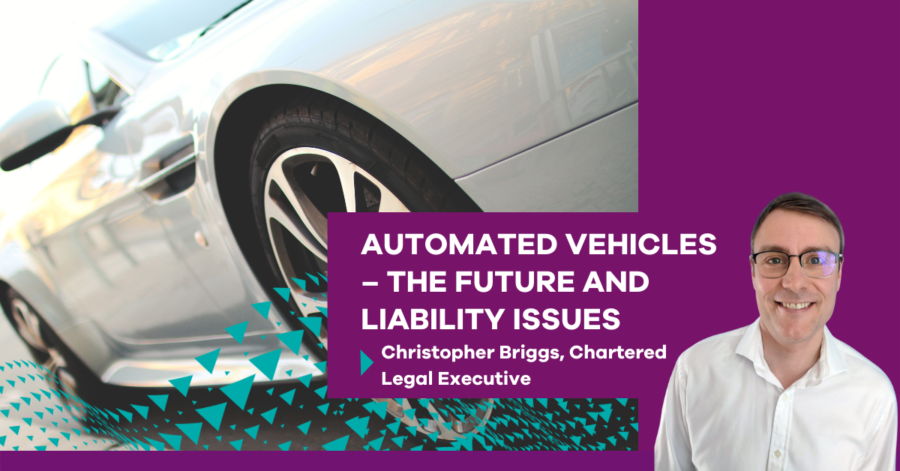
Christopher Briggs, chartered legal executive at Minster Law, discusses the future of automated vehicles and liability issues.
Had the makers of Back To The Future 2 been correct, then by now flying cars would be the norm. Whilst this is not the case, for a few years now Automated or self-driving vehicles have been under development.
At the present time there are vehicles already fitted with this technology, and whilst driving in self-driving mode is currently not legal on Britain’s roads, this is going to change within the next year.
So, who and where does the liability fall if such a vehicle is involved in an accident?
Although these vehicles will be equipped with technology to reduce accidents, it is unlikely that they will prevent them in their entirety. So, if you are at fault, then the issue of liability should follow the usual, and current procedures. But if the automated vehicle is at fault, then what?
The issue of where liability falls is set out within Part 1 of The Automated and Electric Vehicles Act 2018[1]. Section 2(1) of the act says:
Where—
- an accident is caused by an automated vehicle when driving itself on a road or other public place in Great Britain,
- the vehicle is insured at the time of the accident, and
- an insured person or any other person suffers damage as a result of the accident,
the insurer is liable for that damage.
But if the vehicle, is not insured, then Section 2(2) of the act makes it clear that it’s the owner of the vehicle who would be liable.
However, this isn’t as simple as it appears on the face of it because not all vehicles that might be fitted with self-driving technology may be considered to be an automated vehicle under the Act. Section 1 of the Act sets out that the Secretary of State will make a list of approved vehicles which will be deemed to be automated vehicles and section 1(4) makes it clear that it will only be those vehicles where the section 2(1) and liability will apply.
As of today, there are vehicles on the road that are capable of self-driving, but these may not meet the criteria, which is unknown and not set out within the act, for the list. The Society of Automotive Engineers has defined 6 levels of automation from Level 0 – No Driving Automation, to Level 5 – Fully Automated.
So, if the vehicle is on the approved list, insured and at fault then the insurers will meet liability. I expect that in most circumstances this will be the situation, but there is a possible get out clause still and this is dealt with at Section 4 of the Act and concerns the self-driving technology. No doubt there will be software updates for these vehicles, but also likely there will be software that will become available that might improve performance of the self-driving vehicle or alter the self-driving capabilities.
Section 4(1) says:
An insurance policy in respect of an automated vehicle may exclude or limit the insurer’s liability under section 2(1) for damage suffered by an insured person arising from an accident occurring as a direct result of—
- software alterations made by the insured person, or with the insured person’s knowledge, that are prohibited under the policy, or
- a failure to install safety-critical software updates that the insured person knows, or ought reasonably to know, are safety-critical
Therefore, if the insured person has not kept up to date with software updates or has installed unauthorised software the insurer’s can reduce or exclude their liability altogether. However, as noted within the wording of the Act this will come down to knowledge of the insured. There perhaps will be few situations where the insured was not aware of unauthorised software being downloaded, but there is scope for the insured not being aware of the need to download updates for safety critical software, such as not being altered by manufacturers.
More recently, it has been announced that the Highway Code will be updated with changes for the driving of automated vehicles. It was widely reported that when in self-drive mode drivers of these vehicles will be able to watch a film or TV show, which seems to be at odds with the Highway Code update earlier this year where the use of hand-held mobile phones to do such activities was banned.
The key point with this is that the content, film or TV show for example, must be viewed on the in-car display and that the display must alert the driver of the vehicle that they will need to take over control of the vehicle. It won’t be the case that when in self-driving mode, you will be able to leave the driver’s seat, the driver must always be ready to take back control. The proposed amendments to the Highway Code[2] are as follows:
Automated vehicles can perform all the tasks involved in driving, in at least some situations. They differ from vehicles fitted with assisted driving features (like cruise control and lane-keeping assistance), which carry out some tasks, but where the driver is still responsible for driving. If you are driving a vehicle with assisted driving features, you MUST stay in control of the vehicle.
Automated vehicles are vehicles that are listed by the Secretary of State for Transport. While an automated vehicle is driving itself, you are not responsible for how it drives, and you do not need to pay attention to the road. But you must follow the manufacturer’s instructions about when it is appropriate to engage the self-driving function.
If the vehicle is designed to require you to resume driving after being prompted to, while the vehicle is driving itself, you MUST remain in a position to be able to take control. For example, you should not move out of the driving seat. You should not be so distracted that you cannot take back control when prompted by the vehicle.
It seems like it is going to be sometime before we see these cars whizzing along motorways and it is likely that the first wave of these cars will have to be fitted with Automatic Lane Keeping System (ALKS)[3] which is designed for motorways and will be limited itself for speeds of up to 37mph, which is far slower than the vast majority of people travel on motorways, but will have use is speed restricted areas, such as accident areas and roadworks.
Automated vehicles are on their way and will start to be in use, although perhaps in limited situations, in the next year or so. But as technology progresses these vehicles will become a more common sight and may potentially have a far wider reach as they may assist in reducing congestion as the vehicles and road systems will be able to communicate with one another to keep traffic flowing.
Despite the wording of the Act, it seems likely that there will be further developments on the issue of liability where these types of vehicles are involved in collisions surrounding driver alertness, the system altering the driver to taking over control of the vehicle and software updates.
It will be interesting to see not only how this technology develops, but also how case law on the use of these vehicles also develops.
[1] https://www.legislation.gov.uk/ukpga/2018/18/contents/enacted
[2] https://www.gov.uk/government/consultations/safe-use-rules-for-automated-vehicles-av/rules-on-safe-use-of-automated-vehicles-on-gb-roads
[3] https://www.gov.uk/government/news/government-paves-the-way-for-self-driving-vehicles-on-uk-roads



